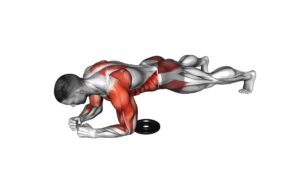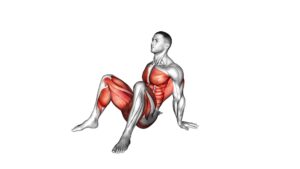Plank Hand Switch (male) – Video Exercise Guide & Tips

Looking to level up your workout routine? Check out the Plank Hand Switch exercise!
Watch This Exercise Video
In this video guide, we'll show you how to perform this challenging move with proper technique. Avoid common mistakes and get tips on increasing difficulty.
Whether you're a beginner or a seasoned pro, this exercise has variations for everyone. Get ready to strengthen your core and improve your stability.
Let's dive in and make those abs burn!
Key Takeaways
- The Plank Hand Switch targets core muscles and improves core strength and stability.
- It enhances shoulder and arm strength while engaging abdominal muscles, lower back, and obliques.
- Proper technique includes starting in a plank position on hands and toes, maintaining proper hand placement, and shifting weight while touching opposite shoulders.
- Common mistakes to avoid include allowing hips to sag or lift too high, rushing through the movement, and holding breath during exercise.
Benefits of the Plank Hand Switch
Get ready to experience the benefits of the Plank Hand Switch, a challenging exercise that targets your core muscles. By incorporating this exercise into your routine, you can improve your core strength and stability, as well as enhance your shoulder and arm strength.
One of the key benefits of the Plank Hand Switch is its ability to strengthen your core muscles. As you perform the exercise, your abdominal muscles, lower back, and obliques are engaged to maintain stability and control. This not only helps to improve your overall core strength, but also enhances your posture and balance.
Additionally, the Plank Hand Switch is highly effective in improving shoulder and arm strength. The exercise requires you to support your body weight on your hands, which engages your deltoids, triceps, and biceps. Regular practice of this exercise can lead to increased strength and definition in these muscles, allowing you to perform daily activities with ease and efficiency.
Now that you're aware of the benefits of the Plank Hand Switch, it's important to understand the proper technique for performing this exercise. Transitioning to the subsequent section, let's delve into the details of the correct form and execution of the Plank Hand Switch.
Proper Technique for the Plank Hand Switch
To perform the Plank Hand Switch correctly, start by assuming a plank position on your hands and toes. This means that your hands should be directly under your shoulders, with your fingers spread wide for maximum stability. The placement of your hands is crucial in maintaining a strong and balanced plank position.
Once you're in the proper plank position, engage your core muscles to create stability throughout your body. The Plank Hand Switch requires you to shift your weight from one hand to the other while maintaining the plank position. This movement challenges your core stability and helps to strengthen your abdominal muscles.
To execute the hand switch, lift one hand off the ground and bring it to touch the opposite shoulder. As you lower that hand back down, simultaneously lift the other hand off the ground and bring it to touch the opposite shoulder. Continue alternating this hand movement while keeping your body in a straight line.
It is important to keep your hips level and avoid any twisting or sagging in your lower back. By focusing on proper hand placement and core stability, you can perform the Plank Hand Switch exercise effectively and safely.
Common Mistakes to Avoid
Avoid these common mistakes when performing the Plank Hand Switch exercise to ensure proper form and maximize effectiveness.
One common mistake is allowing your hips to sag or lift too high. This can put unnecessary strain on your lower back and reduce the effectiveness of the exercise. Keep your body in a straight line from your head to your heels, engaging your core muscles to maintain stability.
Another mistake to avoid is rushing through the movement. The Plank Hand Switch exercise requires controlled and deliberate movements to engage the muscles effectively. Take your time when switching hands, making sure to maintain stability and control throughout the entire movement.
Improper hand placement is also a common mistake. Make sure your hands are directly under your shoulders, with your fingers pointing forward. This will provide a stable base of support and help you maintain proper form.
Lastly, avoid holding your breath during the exercise. Breathing is important for maintaining proper form and providing oxygen to your muscles. Breathe in through your nose and out through your mouth, staying relaxed and focused throughout the exercise.
Tips for Increasing Difficulty
To make the Plank Hand Switch exercise more challenging, try incorporating these tips into your workout routine:
- Ways to challenge yourself:
- Increase the duration: Start by holding the plank position for 30 seconds and gradually work your way up to a minute or more.
- Add weight: Place a weight plate or a sandbag on your back while performing the exercise to increase the resistance and intensity.
- Modifications for beginners:
- Perform the exercise on your knees: If you find the traditional plank position too difficult, start by doing the exercise on your knees. This will help build strength in your core before progressing to the full plank position.
- Reduce the range of motion: Instead of fully extending your arms during the hand switch, start by just lifting one hand slightly off the ground and then switch to the other hand. As you get stronger, gradually increase the range of motion.
Variations of the Plank Hand Switch
Once you have mastered the basic Plank Hand Switch exercise, you can explore several variations to target different muscle groups and add more challenge to your workout.
For those looking for advanced plank variations, you can try the Plank Hand Switch with Leg Lift. In this variation, instead of just switching hands, you also lift one leg off the ground while maintaining a stable plank position. This engages your core, glutes, and hip muscles even more, giving you a full-body workout.
Another advanced variation is the Plank Hand Switch with Shoulder Tap. As you switch hands, you also tap the opposite shoulder with your free hand. This adds an extra challenge to your core stability and shoulder strength.
If you're a beginner or want to modify the exercise, there are a few options. You can start with the Modified Plank Hand Switch, where you perform the exercise with your knees on the ground. This reduces the amount of body weight you have to support, making it easier to maintain proper form.
Another modification is to perform the Plank Hand Switch against a wall. By placing your hands on the wall instead of the floor, you can gradually increase the difficulty as you build strength and stability.
Remember to listen to your body and choose the variation that suits your fitness level.
Frequently Asked Questions
What Are the Potential Risks or Injuries Associated With Performing the Plank Hand Switch Exercise?
When performing the plank hand switch exercise, it's important to be aware of the potential risks or injuries involved. These can include strain on the wrists, shoulders, and back if not done properly.
However, with proper warm up, modifications, and gradually increasing the duration, you can minimize these risks.
Building upper body strength is key to avoiding injuries, so be sure to follow the exercise guide and video tutorial for proper form and technique.
Can the Plank Hand Switch Help in Building Upper Body Strength?
The plank hand switch can definitely help you build upper body strength. By incorporating different variations of the plank hand switch into your workout routine, you can target your arms, shoulders, and chest muscles.
This exercise is highly effective for strengthening your core as well, as it requires stability and balance. The benefits of the plank hand switch for core strength are immense, making it a valuable addition to any upper body workout.
How Long Should One Hold Each Plank Position During the Plank Hand Switch Exercise?
During the plank hand switch exercise, it's recommended to hold each plank position for about 30 seconds. This duration allows you to challenge your core muscles and enhance your upper body strength.
The plank hand switch is a beneficial exercise that targets various muscle groups, including the abs, shoulders, and arms. By incorporating this exercise into your routine, you can improve stability, increase muscular endurance, and develop a strong and toned upper body.
Is It Necessary to Warm up Before Performing the Plank Hand Switch?
Yes, it's necessary to warm up before performing the plank hand switch exercise. Warming up helps prepare your muscles and joints for the workout, reducing the risk of injury.
It also increases blood flow and flexibility, improving your overall performance.
To do the plank hand switch correctly, start in a high plank position, then lower one hand at a time to a forearm plank.
Alternate between hands while keeping your core engaged and your body in a straight line.
Can the Plank Hand Switch Exercise Be Modified for Beginners or Individuals With Limited Upper Body Strength?
Yes, the plank hand switch exercise can be modified for beginners or individuals with limited upper body strength.
Beginner modifications for this exercise may include performing the plank on your knees instead of your toes or using a stability ball under your forearms for added support.
These modifications help to make the exercise more accessible and allow individuals to build strength gradually.
It's important to listen to your body and start with modifications that feel comfortable for you.
Conclusion
In conclusion, the plank hand switch is an effective exercise for strengthening the core and improving overall stability. By switching the hands during the plank position, it engages different muscle groups and challenges the body in new ways.
Remember to maintain proper form and avoid common mistakes to maximize the benefits of this exercise. As you progress, you can increase the difficulty by incorporating variations and adding more repetitions.
Stay consistent and dedicated to achieve optimal results.

Author
Years ago, the spark of my life’s passion ignited in my mind the moment I stepped into the local gym for the first time. The inaugural bead of perspiration, the initial endeavor, the very first surge of endorphins, and a sense of pride that washed over me post-workout marked the beginning of my deep-seated interest in strength sports, fitness, and sports nutrition. This very curiosity blossomed rapidly into a profound fascination, propelling me to earn a Master’s degree in Physical Education from the Academy of Physical Education in Krakow, followed by a Sports Manager diploma from the Jagiellonian University. My journey of growth led me to gain more specialized qualifications, such as being a certified personal trainer with a focus on sports dietetics, a lifeguard, and an instructor for wellness and corrective gymnastics. Theoretical knowledge paired seamlessly with practical experience, reinforcing my belief that the transformation of individuals under my guidance was also a reflection of my personal growth. This belief holds true even today. Each day, I strive to push the boundaries and explore new realms. These realms gently elevate me to greater heights. The unique combination of passion for my field and the continuous quest for growth fuels my drive to break new ground.







